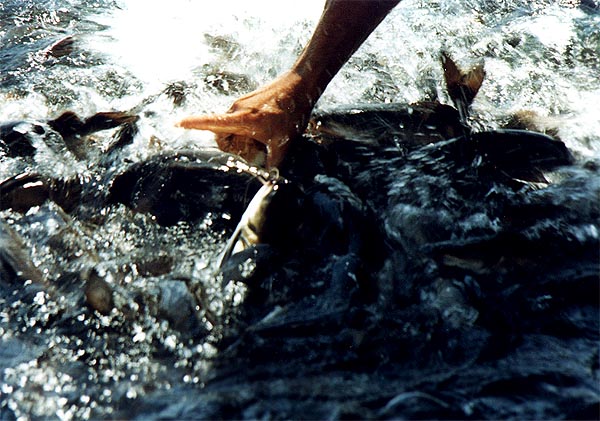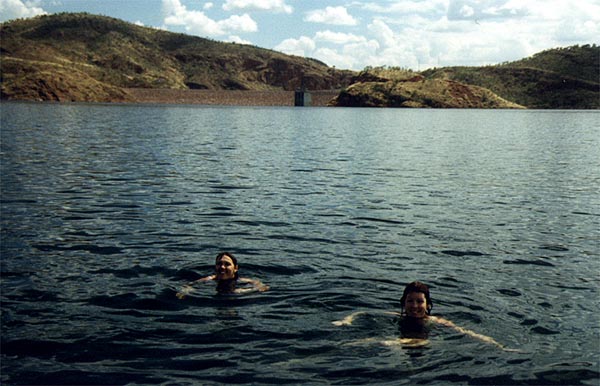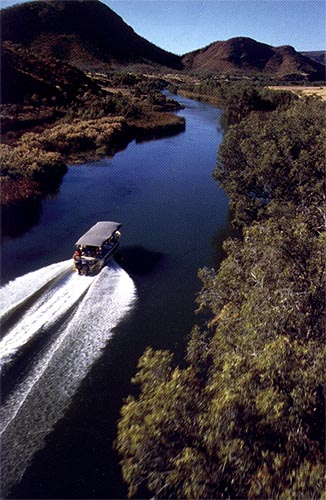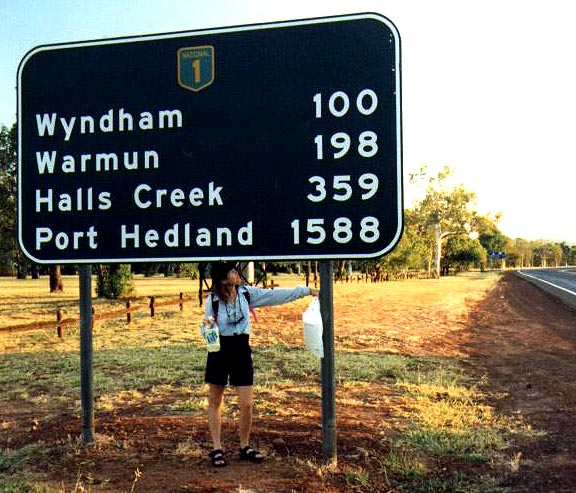|
Karen and I had become accustomed to getting up before dawn. Our body clocks had quickly adapted to the cycle of night and day. The time change at the border did little to affect this situation, with one small exception - our watches now told us the sun was rising at around five in the morning where a day earlier it had risen at seven.
We soon took advantage of our early start to the day. The Kimberleyland (just love that name) caravan park nestles on the shore of Lake Kununurra, a backwater formed by a small diversion dam on the western edge of town. Karen and I walked along the shore of the lake just after dawn looking for birds. A new one was quickly added to our list - the Star Finch. We also saw a crake or a rail in reeds at the water's edge, but it proved elusive and no positive identification was made.
After breakfast we walked the two kilometres or so into the centre of town to visit an information centre, and armed with a new tourist map made our way to Kelly's Knob, a large, rocky outcrop which overlooks the town, the river and its surrounds. We lunched at "Chicken Treat" and then shopped for groceries at "Charlie Carters", strange business names that we chuckled over and which would soon become a familiar part of our everyday Western Australia life.
Back at the caravan park we had a swim and sat by the pool poring over all the tourist brochures we had acquired, eventually deciding on a full day bus tour to Lake Argyle for a cruise and a return down the Ord River. An evening bird walk resulted in a definite sighting of the bird we had missed in the morning - a white-browed crake.
Karen was getting up a couple of times during the night anyway, so she arranged one of her nocturnal sorties to coincide with a viewing of the Eta Aquarids - a meteorite shower caused by the Earth passing through the debris of a long forgotten comet for a few days at the same time every year. She reported seeing quite a few shooting stars, so I resolved to rouse myself the following night for a similar investigation.
We spent a lazy morning swimming and reading, but our rest days were never very restful and we were both soon at work, Karen making sandwiches for a bike ride around the Ord River Irrigation Scheme later in the day, and me moving our tent to a shadier site next door and starting the repairs on my rat-chewed pannier. We paid for two more nights accommodation and for the next day's tour before easing back onto Elle and Mel and venturing forth into the wilds of Kununurra.
Our first stop was at Barra Barra Bananas which Karen insisted was a must-see local attraction. It did not take me too long to work out the reason for her insistence. No sooner had we arrived at the plantation than she was hoeing into a chocolate-coated piece of frozen-mango-on-a-stick. After I talked Karen out of an additional mango smoothie, we rode out to the Ivanhoe Crossing where fishermen have been taken by saltwater crocs, and spied a couple of thrill seekers fishing knee deep in the shallows.

Ivanhoe Crossing
At first I wondered whether the fishing gene is chromosomally linked to the stupid gene, but then I reasoned that the fishermen could justifiably argue that their activities were no more dangerous than riding bikes and dodging road trains with only a polystyrene hat for protection.
One irrigation area is very much like another irrigation area - lots of levees, green fields, water channels, locks and gates - and the Ord River Scheme was no great exception. Given the fame of the scheme and the huge amount of water stored in Lake Argyle, it came as a real surprise to find how small the irrigated area actually is. Karen and I easily rode around the perimeter in half a day. We heard later that two stages of the scheme had been completed, but the third stage which was currently under consideration had been stalled due to an aboriginal land claim on the entire Ord River Scheme, including the irrigated areas, the diversion dam, the much larger Argyle dam and the entire expanse of water backed up behind it. For some reason, however, the aboriginals did not seem the least bit interested in the other million square miles of undeveloped land just outside this area.
We rode into the Hidden Valley national park on the eastern edge of the town where we lunched and did the scenic walk. At one point I sat down to wait for the sun to come out from behind some rogue clouds in order to take a photo of an impressive rock formation. Karen carried on to return to the bikes, but soon became confused by the maze of rock pagodas and promptly got lost. Before doing the right thing and retracing her steps back to the last place where she knew she wasn't lost, Karen spotted a rare White-quilled Rock Pigeon.
The tourist blurb said that Hidden Valley was just as spectacular as the Bungle Bungles. The small national park was okay, but the tourist blurb had obviously been written by an advertising man, and not by someone with objective views connected with reality.
We did a bit of shopping on our way back through town. As usual I waited outside with the bikes while Karen was inside, but when she could not work out what sized can of WD-40 she should buy she looked after the bikes while I went into the supermarket to select the correct item. On my return Karen was being hassled by a couple of inquisitive young delinquents who were asking questions about the bikes and touching the computers and pumps and panniers. The kids beat a hasty retreat when I arrived on the scene. Maybe because I am tall they thought I was also tough. If they did, they were wrong.
Back at the caravan park we swam some more, read, prepared for our nightly battle with the mozzies and Karen cooked dinner while I finished my pannier repairs. I retired early to rest for the 3am meteorite observation, but it did no good and I slept right through the twenty seconds of beeps from my watch alarm. I dredged myself up from the depths of sleep at 3:48am and managed to spot twelve meteorites in twenty minutes, not an impressive display on the fireworks scale but right up there for night sky watchers.
We rose at dawn to make preparations for the day trip to Lake Argyle. Three hours later at 8:30am we were picked up at the caravan park office and bussed to a cruise boat named "Bowerbird" at the lake. Our two hour cruise began with a run past the dam wall and the intake structure for the turbines in the power station at the foot of the dam. We passed through the "heads" where the initial part of the lake is almost pinched off from the huge expanse beyond, and cruised over to a small island, seemingly populated by nothing but huge, golden orb-weaving spiders. Peter, the captain of the boat, then explained that the lake was populated by three different species of catfish, one of which was excellent eating and was harvested daily for the Australian fish markets. Catfish is not a popular fish on the tables of most Aussie families, so its name had been changed to something more edible - silver cobbler.
Peter went on to explain that silver cobblers made up only a small percentage of the catfish in the lake, with another species being dominant. He proved this by throwing a few bread rolls over the side of the boat. The still waters of the lake were instantly transformed into a seething mass of black bodies, white mouths and whiskers as the catfish massed together, all desperate to get at the free food - a bit like Karen really. The fish were so thick that Peter could not force a bread roll through the throng and into the water. He then said that the catfish were incredibly easy to catch, and demonstrated this by sticking his thumb into one of the thousands of open mouths and pulling a fish from the water when it bit down.

Catching a fish with your thumb
Milling around the edges of the boat away from the madding crowd were scores of small, striped fish which Peter identified as archer fish. Karen and I had seen this fish many times in many wildlife documentaries. It spits a jet of water at insects on branches above the surface, knocking them into the water for easy consumption, but we had never witnessed it in real life. Peter held out a very un-insect-like bread roll which was zapped from three or four directions immediately. Some jets were spat up to three metres high, and once the fish got into the swing of things, all the rest of us had to do was lean over the side of the boat to receive a face full of fish spit.
The abundance of fish in the lake also meant that there was an abundance of freshwater crocs in the lake as well. We had seen none, but this was due to the temperature of the water. Crocs sun themselves on the shore to raise their cold-blooded body temperatures. Because the water in the lake is around thirty degrees Celsius, the crocs were warm enough and did not need to show themselves. Conservative estimates put the number of crocs in Lake Argyle at twenty five thousand, so when Captain Peter suggested a swim, Karen and I were amongst the first people into the water. For ever more we can boast that we have swum in a lake filled with twenty five thousand crocodiles!

Karen swimming with 25000 crocodiles
After lunch we toured the Durack Homestead which had been re-sited after its original location had been flooded by the waters of Lake Argyle. Apparently the waters of the lake rose far quicker than expected after the completion of the dam, which forced the dismantling and relocation of the homestead to be abandoned before it could be completed. As a result, the bottom couple of feet of all the walls are not original. The most interesting part of the homestead - at least to Karen and me - was a Great Bowerbird bower under a shrub in the garden.
The bus then dropped us at a jetty at the foot of the dam wall where we boarded the "Osprey" - a big, flat bottomed boat powered by a couple of two hundred and twenty five horse power engines that soon had it flying along the smooth river. Captain Jeff, one of the J's of JJJ Tours, knew every inch of the Ord, and the four hour cruise down the fifty five kilometres of river to Kununurra was the highlight of the day. High speed dashes through the narrow twists and turns of the Ord were punctuated by lengthy stops whenever Jeff saw something that interested him. He stopped to let us watch a flying fox colony for a few minutes. He stopped every time he saw crocs drifting along the river or sunning themselves on a bank. We motored up side creeks, we were given expert commentary on all of the trees and birds and history. Afternoon tea was taken at a permanent camp along the river, shortly after Karen had spotted another new bird - the collared Sparrow hawk. Jeff's dry wit and sense of humour had the Aussies on the tour all laughing, but I suspect the foreigners on board took everything he said at face value and wondered what we found so funny.

The trip down the Ord
As dusk approached, Jeff broke open an Eski containing half a dozen bottles of wine and champagne. With a beautiful golden sunset in the western sky providing a perfect backdrop, we cruised slowly along the tranquil waters of Lake Kununurra, quietly sipping bubbly as we enjoyed a calm and peaceful ending to the day. Karen and I were dropped at the Kimberleyland jetty, only a stone's throw from our campsite. The day tour to Lake Argyle will go down as one of the best we have ever done.

Wine and cruising
Our last morning in Kununurra was spent on more tourist stuff, this time a ride out to the Zebra Rock Gallery where striped rock from a local quarry had been carved and polished into a variety of shapes, some obviously for the tourist market, but others destined for collectors of fine art and crafts. The rock work was excellent, but the gallery visit will remain in our memories because of two other events. As we walked through the gardens of the gallery, Karen and I approached a series of large bird cages. We were surprised to see that one contained an Australian Raven, more commonly known as a crow. A voice said "hello" and we looked around to find we were alone. It took us a few moments to realise that the greeting had come from the Raven! It enunciated the word perfectly. Although we had been birdwatchers for quite some time, we had no idea that Ravens are mimics.
The gardens led down to a jetty on Lake Kununurra. Large rafts of thick, floating weed lined the area around the jetty. Karen and I had been given a small bag of bread by the owners of the gallery, along with directions to the river and instructions to feed the fish. We threw a few crusts into the water and it was the Lake Argyle fish feeding all over again. Hundreds of catfish massed on the surface, squashed together and all desperately begging for another piece of bread. The rafts of weed were pushed around like pieces on a chessboard as the fish fought for ascendancy over each other. We snapped a couple of photos of the amazing scene.

The catfish in the Ord
The afternoon was reserved for preparations for moving out the next day. We walked into Kununurra and rang Perth, leaving a message on a friend's answering machine saying that we were sending her a package of gear we did not need, and could she look after it until we arrived. Karen and I had worn jeans on the plane from Sydney to Darwin, and had not worn them since. They were just dead weight, so we sent them ahead. We bought food, a new bike tube and picked up some advice on some farm accommodation near the Dunham River which would later come in handy. We filled our last night in Kununurra with an expensive dinner at the Chopsticks Chinese restaurant, then bought ice-creams at a service station on a long, dark and dangerous walk back to the caravan park.

We would visit all four of these places
The change in time zones gave us our earliest start since Darwin the next morning - 6:30am. Highway One in the Northern Territory had been called the Victoria Highway, but from the Western Australian border it had been called the Duncan Highway. About forty five kilometres took us to an intersection with the Great Northern Highway which is what Highway One is called between Wyndham and Port Hedland. Karen and I turned right and headed north for Wyndham. It meant a side-trip of sixty kilometres in and sixty kilometres back out again, but having ridden so far already, it seemed a bit petty to pass the town by.
The undulating country through which we had been riding became hillier after the turn, a hot northerly headwind not helping our cause. Eight kilometres up the road we passed a turn-off to the left which marked the start of the Gibb River Road. Karen and I had often been asked whether we intended taking this road, but we were not interested in large distances over dirt roads and intended sticking to the highway. A further fifteen kilometres up the road we reached another turn-off where a small road sign announced that the Grotto was one kilometre away. It sounded cool and shady, the perfect place for lunch, and maybe even a swim, so we started up the dirt road. Bad move.
If the road into the Grotto is one kilometre long then I am only three feet tall. It just went on and on, a lousy little dirt road strewn with small, sharp rocks that took direct aim at my back tyre and scored a direct hit. Hey presto - one puncture. I tried using a glueless patch, but my tyre went flat as soon as I started riding again, so off came the wheel again, out came the tube and in went a new one. Just to make sure that we did not puncture again, we walked the bikes the last half a kilometre to the carpark at the end of the road.
A defined track led away towards a small gorge. Karen and I left our bikes against a wall in the carpark and followed the track to a small cliffline where a series of steps led down to a deep pool. The Grotto would probably have been quite scenic when the water was flowing, but the Dry was in full swing and a few meagre drips were the only indication of the waterfall at the end of the pool. The water was tinged green and full of algae, with small dead fish littering the surface and surrounding rocks. Karen and I were not tempted to go in for a dip. We returned to Elle and Mel and walked them all the way back to the highway. The Grotto had not been one of our better side trips.
Another six kilometres up the road we found a parking bay and pulled off the highway for a long overdue lunch. The parking bay was a shocker, the seating provided in the form of a jumble of large cement blocks. There was no shade, no toilets, not even a bin, and the only water available was a trench of muddy water about forty metres long and ten metres wide. A very noisy diesel pump was sucking up the brown muck and depositing it into a succession of water tankers that came and went as we were eating. Somewhere ahead of us there were road-works in progress. The rest area at the major intersection of the highways earlier in the day had boasted only a few sheltered tables, a toilet and a bin. This latest example of Western Australian roadside hospitality left us very unimpressed.
The road wound its way over some sharp hills as we slogged onwards into the headwind after lunch. We hoped the wind would still be the same when we rode out a couple of days later. After a long, hard day we passed the Largest Concrete Crocodile in Captivity and rode joyously into Wyndham.

The Largest Concrete Crocodile in Captivity
While Karen shopped at a small supermarket, I was accosted by an aboriginal gentleman as I waited outside with the bikes. He was as black as the ace of spades, with the worst skin I have ever seen, almost the texture of a cauliflower. It was so fascinating, I found it hard to concentrate on what he was saying to me, a task he was not making any easier by his being very happily drunk. He introduced himself as Mop, and we chatted in a fashion for about five minutes before Karen worked up the nerve to come out of the shop. A pair of Scottish tourists found the whole episode quite amusing, and asked Karen and I to stand with Mop while they took our picture. Somewhere in Scotland right now there is a photograph of a very black, very drunk aborigine with his arms around the shoulders of two very bEmused cyclists.
The one hundred and six kilometres we racked up for the day gave us a grand total of over a thousand kilometres since leaving Darwin, but on the map the distance we had covered was minuscule when compared with the distance still remaining until Perth. We had barely entered Western Australia, and the bulk of the largest state of the Earth's largest island still lay before us.
We rode out to a caravan park and had the run of the camping area with only one other tent in occupation. Our new neighbour appeared just as we were about to make ourselves a cup of coffee. He seated himself in a fold-up chair next to his tent, pulled some makings out of a canvas shoulder bag and proceeded to roll himself a cigarette. When it was lit he inhaled deeply before blowing out a satisfied sigh of smoke. Casually, he turned his head in our direction, made eye contact and nodded his head in greeting.
That was how we first met Brian.
|







